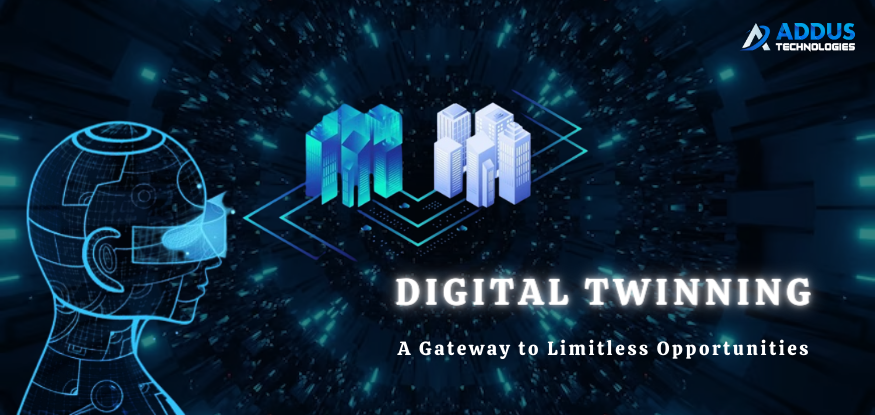Digital Twinning: A Gateway to Limitless Opportunities

In today’s rapidly evolving tech world, the concept of the virtual world has gained a wide range of popularity and attraction all over the world. These virtual environments allow individuals to interact with computer-generated spaces and objects, creating a new ocean of possibilities for various industries across the world. One of the key technologies driving the development of virtual worlds is the concept of digital twins. The birth of this digital twin technology has significantly influenced many entrepreneurs and businesses and has opened a new ocean of opportunities. Lets explore the endless possibilities of this astonishing trend below
Understanding Digital Twins
A digital twin represents a physical object, person, or process in a digital version of their environment. It involves the use of advanced technologies such as artificial intelligence, machine learning, and the Internet of Things to capture real-time data through sensors and devices, feed it into a platform, and generate a digital twin that replicates the physical entity. This virtual replication mirrors the physical attributes, behaviors, and characteristics of the original version. This digital twinning tends to establish a real-time connection between the physical and virtual worlds and update itself based on the real-time data that is being fed to it.
Main Elements of a Digital Twin Technology
To understand the core concept of digital twinning, it is necessary to understand the main key elements of digital twinning:
Physical Entity
It refers to the original object, system, process, or anything that the digital twin represents.
Data Acquisition
A vast amount of data is needed to craft an accurate and reliable digital twin. The data may be sensor readings, historical data, or any other relevant information that represents a comprehensive view of the physical entity.
Virtualization
Once the data is collected, it is processed to form the virtual replica. By incorporating advanced technologies such as machine learning, artificial intelligence, and complex algorithms, an accurate and realistic digital twin is achieved.
Analysation
After the creation of a digital twin, it can be visualized and analyzed in a real-time environment. This analysis paves the way for in-depth examination, identification of patterns or anomalies, and the ability to simulate different scenarios for optimization and problem-solving purposes.
Applications of Digital Twins in Various Sectors
Energy Sector
The energy sector has undergone a significant change with the birth of digital twin technology. The digital twin allows power plant operators to monitor and optimize the performance of the asset in real-time. By creating virtual replications of power units, turbines, and auxiliary systems, operators can track key parameters, analyze performance data, and identify potential issues at an early stage.
Sustainability is a top priority in the energy sector. By creating digital twins of energy-intensive processes, such as water treatment plants or oil refineries, operators can monitor and analyze resource usage, identify inefficiencies, and implement optimization strategies. Real-time data and predictive analytics enable operators to minimize resource wastage, reduce environmental impact, and improve overall sustainability.
Manufacturing Industry
Digital twinning plays a vital role in the manufacturing industry by creating a digital replica of production lines. Through this, manufacturers can simulate and analyze different scenarios and identify obstacles and inefficiencies in real-time. This probably results in optimizing their overall production processes, reducing downtime, and enhancing productivity. For example, by visualizing and analyzing the data recorded by sensors, manufacturers can prevent any costly breakdowns, predict the exact requirements for maintenance, and ensure uninterrupted production.
Also, designers can test and refine their ideas in a virtual prototype without the need for a physical prototype. This will significantly reduce both time and resources. By conducting simulations of digital twins, manufacturers can gather real-time feedback on product performance.
Healthcare Industry
The healthcare industry is another sector where digital twinning is making a significant impact. Surgeons can now create virtual replicas of patient anatomy, enabling them to plan complex procedures with more precision and accuracy. By simulating surgeries with the help of digital twins, surgeons can predict potential complications, test different approaches, and optimize surgical outcomes. This not only improves patient safety but also reduces the complexities associated with surgical procedures.
Digital twinning is also revolutionizing the way healthcare professionals provide personalized patient care. By analyzing data from wearable devices or electronic health records, doctors can create virtual replicas of individuals and monitor their health in real-time. Through this, doctors can predict potential health issues and develop customized treatment plans. This forward approach to patient care leads to better health outcomes and improved patient satisfaction.
Transportation Industry
In the transportation industry, digital twinning tends to optimize traffic management and improve the overall efficiency of transportation networks. By integrating data from different sources, such as traffic cameras, GPS systems, and weather conditions, digital twins for cities or road networks can be created. These digital twins enable transportation authorities to simulate different traffic scenarios, predict over traffic, and identify areas that require infrastructure improvements. This empowers them to make data-driven decisions and implement effective solutions to reduce overcrowding and enhance the overall performance of the transportation systems.
Digital twinning also proves to be a notable technology in the maintenance of transportation vehicles. By creating virtual replications of vehicles, manufacturers and transportation companies can monitor their performance, detect potential issues early on, and schedule maintenance and repairs more actively. This reduces the risk of breakdowns, minimizes costly downtime, and ensures the safety and reliability of the entire transportation sector.
Aerospace
Digital twin technology has significantly transformed the way aircraft are designed and developed. By creating a virtual representation of an aircraft and simulating its performance under different conditions, engineers can identify flaws, optimize aerodynamics, and fine-tune its operational efficiency long before constructing the physical prototypes. This not only saves time and resources but also improves the overall safety and performance of the final product.
Digital twin technology also empowers aerospace organizations to optimize the overall performance and efficiency of their operations. By analyzing the data collected from real-time monitoring, simulations, and historical records, operators can identify opportunities for improvement, fine-tune operational parameters, and optimize energy consumption. This data-driven approach enables organizations to streamline their processes, reduce waste, and achieve higher levels of productivity and sustainability.
Future Advancements in Digital Twinning
As digital twin technology continues to advance day by day, we can expect tremendous possibilities in the upcoming days.
Autonomous Systems
The integration of digital twins with artificial intelligence and machine learning will lead to the birth of autonomous systems that can optimize their performance, adapt to changing conditions, and make informed decisions.
Personalized Experiences
Integrating digital twins with the metaverse will facilitate personalized experiences for individuals. From virtual travel and entertainment to education and healthcare, virtual landscapes will provide unique preferences and needs.
Collaborative Creation
The metaverse and digital twins together will foster collaborative creation on an unprecedented scale. Individuals and organizations will come together to co-create, exchange ideas, and build immersive virtual environments that surpass the limits imposed by physical boundaries.
Conclusion
As we conclude our exploration of the boundless possibilities of digital twinning, one thing becomes abundantly clear about digital twinning, i.e., this groundbreaking technology has the potential to revolutionize countless industries. Through this ever-evolving technology, various industries are undergoing radical transformations, resulting in increased efficiency, improved decision-making, and enhanced customer experiences. Moreover, the collaboration of digital twins with the metaverse and virtual land propels us into an era where our imagination is the only limit. As the world of digital twinning continues its expansion, we can expect to see increased efficiency, improved decision-making, and enhanced outcomes across various sectors. With its ability to provide unexpected insights and its potential for creative problem-solving, digital twinning is set to shape the future of industries worldwide. So buckle up and get ready for the exciting journey that lies ahead in the realm of digital twinning.
